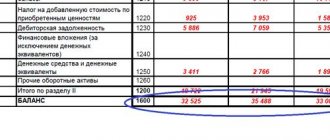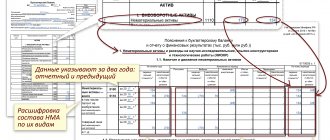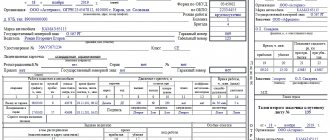Vacation reserve as an estimated liability
According to PBU 8/2010 “Estimated Liabilities”, organizations must create certain amount-weighted liabilities in their accounting accounts. That is, financial statements must contain not only data on the company’s documented obligations to contractors and third parties, but also information on planned expenses that are inevitable.
For example:
- future employee holidays;
- planned tax assessments;
- costs for suppliers in terms of expenses that we know for sure that they will be (for example, if a work completion certificate already exists, but has not yet been signed, so it cannot yet be recorded, although it is known for sure that the director will sign the document will be held next month).
With the advent of this information, the balance sheet becomes the most reliable, since it reflects the most realistic picture of the financial position of the enterprise. Let's take a closer look at what a reserve for vacation pay is.
Each employee, in accordance with labor legislation, is entitled to at least 28 calendar vacation days, and in a number of legally established cases this figure may be higher. Thus, for each reporting date we have vacation days that have not yet been used by employees (it is difficult to imagine an organization in which all employees took 28 vacation days at once). Accordingly, for each reporting date, there are estimated obligations of the company to employees to pay for these days and, as a result, certain obligations to funds to pay insurance premiums.
Who is responsible for reporting this information? In accordance with paragraph 3 of PBU 8/2010, all companies are required to reflect these accruals, with the exception of small enterprises (issuers of securities are not included in such exceptions), which can use a simplified method of accounting. The characteristics of such companies are specified in the Law “On Accounting” dated December 6, 2011 No. 402-FZ.
Thus, if a company does not fit the definition of a small business entity, the accrual of valuation reserves becomes mandatory, and the absence of this information on the accounting accounts may be regarded as a violation of the rules for accounting for income and expenses. Responsibility for this comes on two grounds:
- for gross violation of accounting for income and expenses under Art. 120 of the Tax Code of the Russian Federation in the amount of 10,000−30,000 rubles;
- administrative liability applied to officials under Art. 15.11 Code of Administrative Offences.
IMPORTANT! If a company creates a reserve for vacation pay, it is necessary to stipulate this in the accounting policy, as well as the procedure for calculating this reserve.
https://youtu.be/UHep3xgGGNc
What are estimated liabilities of an enterprise
An estimated liability is a debt of an enterprise, the exact amount and repayment period of which is currently not possible to reliably determine. In fact, this is money reserved for future expenses (in simple words, these are reserves for debts that may have to be paid in the future, and the amount of which is still unknown).
Important! The company must have documents confirming the validity of the amount of estimated liabilities (this is required by the accounting regulations).
Estimated liabilities may arise on the balance sheet of an enterprise for the following most common reasons:
- the appearance of debt as a result of the requirements of the law, regulations, business customs, or court decisions;
- the emergence of a debt to an individual or legal entity due to the need to fulfill obligations that resulted from business transactions of previous periods (for example, an announcement of company restructuring).
Reflection of the vacation reserve in accounting
The calculation and reflection of the vacation reserve in accounting must be carried out at each reporting date. According to current legal requirements, the balance sheet is compiled once a year - that is, December 31 will be the reporting date.
For information about when to submit financial statements, read our material “When to submit a balance sheet - deadlines, nuances.”
However, it is more accurate and correct (primarily for management accounting) to form vacation reserves on a monthly basis, since this type of reserve depends on the number of employees and vacations taken - and these values can change very often. It should be understood that monthly reserve calculation is labor-intensive. The organization needs to independently determine the desired frequency of settlements and record it in its accounting policies.
In accounting, account 96 is intended to reflect such information. All planned costs of the company are accumulated on it, including vacation pay. In this case, a separate sub-account is opened for each type of expense.
Let's consider typical transactions for the accrual and write-off of reserves in correspondence with the account. 96:
| Account Dt | Account name | Kt account | Contents of operation |
| 08 | Fixed assets | ||
| 20 | Primary production | 96.01 “Reserve for payment of employee vacations” | A reserve for employee leave has been accrued (accounts are selected depending on the department in which the employee works) |
| 23 | Auxiliary production | ||
| 26 | General expenses | ||
| 44 | Selling expenses | ||
| Other expense accounts of the company, which account for salary expenses | |||
| 69 (according to subaccounts) | Settlements with extra-budgetary funds | 96.01 “Reserve for payment of employee vacations” | Insurance premiums are calculated from the amount of the calculated reserve |
| 96.01 | Reserve for employee vacation pay | 70 “Labor expenses” | Vacation pay accrued at the expense of the created reserve |
| 69 “Settlements with extra-budgetary funds” | Insurance premiums accrued from the reserve | ||
As you can see, the reserve is always accrued to the same accounts as employee salaries. Insurance premiums are calculated according to the same principle, but in correspondence with the reserve account, and not with accounts for settlements with extra-budgetary funds.
The balance of account 96 when generating periodic reporting is reflected in the liability side of the balance sheet. Line 1540 “Estimated Liabilities” is intended for this purpose.
Please note: if reserves in an organization are created only in accounting, then the base for calculating income tax is not reduced, and temporary tax differences arise, in accordance with PBU 18/02. If the accounting policy for tax accounting states that this reserve is taken into account when calculating income tax, the right appears to create it in the manner specified in Art. 324.1 Tax Code of the Russian Federation.
IMPORTANT! Creating a reserve for tax purposes is a voluntary matter, depending only on the decision of the business entity.
You can read more about the information required to be reflected in the accounting policies in our article “Accounting Regulations and Accounting Policies of the Organization.”
You can read about the provisions of tax policy in the material “How to draw up an organization’s tax policy?”
Reserves for future expenses: account closure
During the production process, the size of the created reserves may change, so by the end of the year there may be an overexpenditure of reserve funds or an excess of actually incurred expenses over the reserve. Excess of the reserve may be written off against current expenses (with appropriate justification). If at the end of the year there is a balance of reserve funds, it is reversed or transferred to the next financial year. It is important to consolidate the operations of maintaining and closing the 96th account in the accounting policies of the organization.
Methodology for calculating the amount of reserve for vacation pay
Since the formula used to calculate the amount of the reserve is not defined by law, each company determines it independently. In this case, the developed method should be fixed in the accounting policy.
IMPORTANT! Any estimated liability should be as close as possible to a reliable monetary estimate of future expenses. The reserve should be determined on the basis of existing facts of the organization's economic activity, and the calculation should be based on accumulated work experience and, possibly, some expert opinions. That is, calculations must be supported by documents and be extremely justified.
Thus, to justify the amount of the accrued reserve for vacation pay, the organization must have:
- A method for calculating a reserve established in the accounting policy that would provide a reliable estimate of expenses for this item.
- Developed primary document to reflect the calculated reserve (certificate, for example). It is worth attaching a primary document, the information on which was used in the calculation (time sheet, pay slip, etc.).
There are several ways to calculate the reserve for vacation pay. First, let's look at one of them, which is fairly accurate - it is based on the actual number of unused vacation days and the average daily earnings of employees:
- First, you should break down all employees by department to determine which cost accounts are used (20–26, 44, etc.).
- It is necessary to have information on the number of vacation days entitled to each employee. If you have automated accounting, collecting this information is not difficult. These days should be summed up for each employee group.
- We calculate the average daily earnings (ADE) of workers for each group. To do this, you must first divide all employee salaries for the past selected period (month, quarter) by the number of calendar days in this period, and then by the number of employees in the group. Visually, this formula looks like this:
Employee SDZ = Salary / DN / K,
Where
ZP - salary for the period,
DN - calendar days of the period,
K is the number of employees in the group (or the company as a whole).
IMPORTANT! Calendar and working days should not be confused, since the number of vacation days is always counted in calendar days - therefore, earnings for calculating vacation pay should also be counted in calendar days.
- The final point is to calculate the amount of the reserve itself (do not forget to calculate insurance premiums from this reserve). The final reserve amount will be calculated using the following formula:
Reserve = (employee SDZ × K × DNO) + (employee SDZ × K × DNO) × St,
Where
DNO - days of unused vacation,
Cst - the total rate of insurance premiums in%.
Read more about the rates of insurance premiums and objects of taxation in our section “Insurance premiums”.
IMPORTANT! The most accurate way to calculate the reserve is to calculate it individually for each employee. In this case, the amount of the reserve will consist of the amount of obligations to each employee. However, if the number of employees in the company is large, this process will be quite labor-intensive.
Formation of estimated obligations for payment of vacations in 1C: ZUP
Let us recall that an enterprise is not obliged to accrue estimated liabilities provided that it is small. Otherwise, it may not accrue estimated liabilities for tax accounting, but for accounting, estimated liabilities will still have to be accrued.
It is possible to choose the method of calculating estimated liabilities for accounting:
- Liability method (IFRS) - uses vacation balances in 1C: ZUP 3.1 to calculate.
This method calculates how many total vacation days the employee has earned at the end of the month. The calculation coincides with the number of vacation days that is calculated upon dismissal of an employee.
Next, the system calculates the average earnings for each employee in a given month. After this, the amount of OO accrued in the previous month is deducted. As a result, provided that the employee did not take vacation in a given month, we obtain an increase in OO equal to the number of days of vacation earned per month, multiplied by the average earnings in the month. Next, you need to calculate the amount of contributions to the funds and add them as expenses. As a result, we get an amount that is as close as possible to the amount of actual vacation costs for this employee.
- The standard method is the amount of estimated liabilities, calculated as a percentage of the payroll.
This is a less accurate, but much simpler method than IFRS, since the process of accruing estimated liabilities takes much less time, and the amount of accrued estimated liabilities is easy to check by calculating the percentage of the payroll. In addition, if we calculate estimated liabilities for tax accounting, then this method will save us from temporary differences, since the same methodology should be used in tax accounting (for tax accounting, this is an opportunity to accrue OO).
In the ZUP 3.1 program, at the end of the year, an inventory of assets takes place, during which the calculation in both accounting and accounting records is carried out according to the IFRS algorithm. As a result, the same amount is accrued for both accounting and NU. Thus, temporary differences disappear at the end of the year.
Free expert consultation
Natalia Sivorina
Consultant-analyst 1C
Thank you for your request!
A 1C specialist will contact you within 15 minutes.
An example of calculating and reflecting the vacation reserve in the accounting accounts
This is an example of the above method of calculating the reserve - based on average earnings. Below you will see examples for other reservation options.
Example
reflected in the accounting policy that the reserve for vacation pay is formed quarterly. To calculate wages and insurance premiums, account 44 “Distribution costs” is used; in total, the company employs 20 people. The company has no grounds for applying reduced or increased insurance premiums (the total rate of insurance premiums is 30.2%). As of March 31, 2020, the data for the quarter is as follows:
- number of days of unused vacation - 134;
- for the 1st quarter, the amount of accrued wages amounted to 678,000 rubles;
- there are 91 days in the quarter.
- Let's calculate the reserve as of March 31, 2020:
SDZ = 678,000 / 91 / 20 = 372.53 rubles.
The reserve amount is 372.53 × 134 × 20 + 372.53 × 134 × 20 × 30.2% = 998,380.40 + 301,510.88 = RUB 1,299,891.28.
Postings:
Dt 44 “Sales expenses” Kt 96.01 “Vacation reserve” - RUB 998,380.40.
Dt 69 “Extrabudgetary funds” Kt 96.01 “Vacation reserve” - RUB 301,510.88.
- Let’s add a few more data to this example to understand how the vacation reserve is adjusted:
- as of March 31, 2020, a reserve for vacation and insurance premiums was accrued in the amount of RUB 1,299,891.28;
- in the 2nd quarter, the amount of accrued vacation pay and insurance contributions from them amounted to 140,900 rubles;
- the number of unused vacation days at the end of the 2nd quarter is 120 days;
- wages for the 2nd quarter and the number of employees remained the same as in the previous period.
Thus, as of June 30, 2020, the amount of the unused reserve amount is equal to 1,299,891.28 – 140,900 = 1,158,991.28 rubles.
Reserve amount as of 06/30/2020:
SDZ = 678,000 /91 / 20 = 372.53 rubles.
The reserve amount is 372.53 × 120 × 20 + 372.53 × 120 × 20 × 30.2% = 894,072 +270,009.74 = 1,164,081.74 rubles.
Amount for contributions to the reserve as of the end of the 2nd quarter:
1,164,081.74 (calculated reserve) – 1,158,991.28 (reserve balance, balance on account 96) = 5,090.46 rubles.
If the amount of the reserve on the account. 96 exceeded the calculated amount at the end of the quarter, the reserve should have been reduced. In our case, it is necessary to make an additional accrual posting.
Postings:
Dt 44, 69 Kt 96.01 - 5,090.46 rub.
Calculation and accrual of vacation reserve in 1C
In order to create a vacation reserve in 1C: ZUP, you must use the document “Vacation Reserves” (section “Salary - Vacation Reserves”). Before you start creating this document, be sure to:
- Accrue all vacations;
- Calculate salaries;
- Generate the document “Reflection of salaries in accounting.”
Liabilities (reserves) are formed based on the amount of accruals, insurance premiums (which includes contributions for “injuries”) and the amount of accrued vacation at the expense of obligations (reserves) in the current month. In order to begin accruing estimated liabilities in the program from a certain point, as a rule, you need to deposit the balances on the accrued OO. The document “Vacation Reserves” is also used for this purpose.
In our example, the organization data was entered in August 2019:
- The document “Vacation Reserves” is set to the “Adjustment of Balances” mode. We enter only the initial data on accruals of estimated liabilities for the payroll; the corresponding accruals for funds are calculated automatically;
Fig.2 Entering initial balances of vacation reserves
- On the “Liabilities and reserves for employees” tab, enter the amounts for each employee according to accounting and accounting records. On the “Liabilities and reserves of the current month” tab, the same information is displayed by department.
Rice. 3 Entering initial balances
After calculating September, we generate the document “Vacation Reserves” for this period.
In the “Calculation of the current month” mode, the document contains three tabs:
- The “Calculation of obligations and reserves for vacations” tab displays the data on the basis of which the obligations (reserves) were calculated in the document. In our example, the IFRS method is used for accounting, so average earnings are displayed, and data on it can be viewed by clicking the “Change average earnings” button (similar to how this happens when calculating vacation). The calculation algorithm is reflected in the columns “calculated”, “accumulated”, “credited”. The “calculated” column shows the amount of accrued estimated vacation liabilities for the entire time the employee worked in the organization. From this amount the data in the “accumulated” column is subtracted and the amount we see in the “credited” column is obtained. It is in this column that the amount of OO accrued in September is displayed. Note that the “accumulated” column coincides with the balance amount entered in the previous document (Fig. 2);
Fig. 4 Calculation of reserves for vacations per month
- On the “Liabilities and reserves for employees” tab, the accruals made are displayed by employees, departments and methods of reflection. This data can be used to control totals;
Fig.5 Viewing employee data
- On the “Liabilities and reserves of the current month” tab, the accruals made are displayed by divisions and methods of reflection. This data on reflecting the vacation reserve is intended to be transferred to the accounting program (for generating transactions).
Fig.6 Accrued reserves are ready for transfer to the accounting system
Let's say a new employee joins the company. In our example, it was accepted on October 1, 2020. Let's check how the system will reflect its appearance. In the document “Vacation Reserves” it will appear in the October calculation, while the “accumulated” column is still empty.
Fig. 7 Calculation of the reserve of an employee who has worked for one month
Other ways to calculate reserves
As already noted, the algorithm for calculating the amount of the reserve is prescribed in the accounting policy, this is due to the fact that PBU 8/2010 does not contain formulas and methods that allow obtaining the value of the reserve.
In addition to the above method, in practice, you can also use one of the following amounts to calculate the reserve:
- wage fund (hereinafter referred to as OT);
- vacation pay paid for the calendar year preceding the year for which the reserve is created (standard method).
The procedure for calculating the reserve amount is carried out in the following steps:
- determination of the average daily wage fund or vacation pay;
- formation of a reserve.
Let's look at examples of using each of these methods.
Example 1
Molniya LLC's accounting policy reflects the creation of a reserve for vacation pay for 2020 based on labor costs. The organization uses the following formula to calculate the reserve:
(OT + insurance premiums) / 28 × 2.33,
where 28 is the number of vacation days per year for each employee;
2.33 - number of vacation days for 1 month worked.
The reserve is formed at the end of each month. The reserve does not include payments to employees who have not worked for a full month. The amount of the reserve at the end of 2020 is 0 rubles. The OT values for 2020 are presented in column 2 of Table 1. Insurance premiums - 30.2% (including contributions for injuries).
Table 1. Reserve calculation
| Month | FROM | Insurance premiums (OT × 30.2%) | Reserve (OT + insurance premiums) / 28 × 2.33 |
| 1 | 2 | 3 | 4 |
| January 2020 | 100 000 | 30 200 | 10 835 |
| February 2020 | 110 000 | 33 220 | 11 918 |
| March 2020 | 120 000 | 36 240 | 13 001 |
| April 2020 | 100 000 | 30 200 | 10 835 |
| May 2020 | 130 000 | 39 260 | 14 085 |
| June 2020 | 90 000 | 27 180 | 9 751 |
| July 2020 | 108 000 | 32 616 | 11 701 |
| August 2020 | 111 000 | 33 522 | 12 026 |
| September 2020 | 120 000 | 36 240 | 13 001 |
| October 2020 | 100 000 | 30 200 | 10 835 |
| November 2020 | 101 000 | 30 502 | 10 943 |
| December 2020 | 100 000 | 30 200 | 10 835 |
| Total | 1 290 000 | 389 580 | 139 765 |
At the end of each month, Molniya LLC will reflect the accrual of the reserve for 2020: Dt 26 (44.20) Kt 96 in the amount from column 4, i.e. as of 01/31/2020 - 10,835, as of 02/28/2020 - 11,918 , as of 03/31/2020 - 13,001, etc.
IMPORTANT! The reserve amounts are reflected in the balance sheet as part of the indicators in line 1540 “Reserves for future expenses.” Read about changes to the balance sheet from 2020 here.
Example 2
LLC "Molniya" in its accounting policy recorded the creation of a reserve once a year, based on the payment of vacations of the previous year. According to accounting data, these expenses are 960,000 rubles.
Reserve calculation:
Insurance premiums = 960,000 × 30.2% = 289,920 rubles.
Reserve = 960,000 + 289,920 = 1,249,920 rubles.
What estimated liabilities (line 1430) are recognized by enterprises
Important! A company that has the right to use simplified accounting methods may not refer to PBU 8/2010 and not recognize estimated liabilities.
In the accounting of an enterprise, an estimated liability can be recognized only if all of the following conditions are simultaneously observed:
- The amount of the estimated liability can be assessed if there are justifications for such an assessment.
- Due to the need to fulfill the estimated liability, there is a possibility that the economic benefits of the enterprise will be reduced by the amount of funds necessary to repay the debt.
- The company is not able to avoid fulfilling the obligation, since it arose as a result of past events in its economic activities.
Below are the most common cases of recognition of estimated liabilities by organizations. These may be recognized in connection with:
- the fact that the company has undertaken warranty service obligations for the goods it sells;
- the need to quickly pay employees bonuses based on annual work results or for length of service (only if such bonuses are promised by an employment or collective agreement);
- the approaching date of payment to workers of their vacation pay;
- the company’s participation in the lawsuit (in the case where the company has reason to believe that it will win the case, and it probably knows how much compensation the defendant will pay it, since it has reasonably assessed its size);
- the need to pay a fine due to a violation of the law (if in relation to such a fine all conditions for the recognition of estimated liabilities are met);
- understanding that the concluded agreement is unprofitable (if its terms provide for penalties for termination of such an agreement).
Results
Calculating a reserve for vacation pay in accounting is a labor-intensive process, but necessary for both managers (to make the right financial decisions) and accountants (to comply with legal requirements).
Sources:
- Tax Code of the Russian Federation
- Law “On Accounting” dated December 6, 2011 N 402-FZ
- PBU 8/2010, approved. by order of the Ministry of Finance of Russia dated December 13, 2010 N 167n
You can find more complete information on the topic in ConsultantPlus. Full and free access to the system for 2 days.
Write-off of vacation reserve
The vacation reserve is closed when vacation pay is calculated. For example, in November 2020, employees Gold and Simutina went on vacation. Simutina has a rolling vacation for the month of December.
Fig.9 Created holidays
After calculating and reflecting wages in regulated accounting, a new tab will appear in the document “Reflection of wages in regulated accounting” - “Payment of vacations at the expense of estimated obligations”, in which these vacations will be reflected.
Fig. 10 Accounting for vacations created through estimated liabilities
Simutina's vacation is divided into 2 parts, corresponding to two months.
Reports on vacation reserves
Reports on estimated liabilities can be easily found in the “Salaries” section by typing the word “Reserve” in the search bar.
Fig. 11 Reports on estimated liabilities and vacation reserves
The report “Balances and turnover of vacation reserves” shows “collapsed” data on estimated liabilities.
Fig. 12 Report “Balances and turnover of vacation reserves”
The “Employee Leave Reserves” report shows the reserves in detail.
Fig. 13 Report “Leave reserves for employees”
The following report, “Calculation reference “Vacation reserves,” illustrates in detail the calculation for one month.
Fig. 14 Report “Calculation reference “Vacation reserves”
The report displays the same data that is calculated in the “Vacation Reserves” document on the “Calculation of Vacation Obligations and Reserves” tab. The only difference is that, depending on the report settings, we see data from either BU or NU.
Account 96 of the balance sheet: general information
Account 96 of accounting is intended to record information on the creation of reserve funds intended to fulfill the company’s existing obligations. In this case, the accountant evenly assigns funds from reserves to expenses.
96 account – active-passive. The debit will display the actual expenditure of the funds that formed the reserve. And for the loan, the reservation of the calculated amounts in correspondence with the accounts is demonstrated:
- expenses for sales of goods/services;
- accounting for production costs.
An example of calculating the amount of an estimated liability
Svet LLC received a subpoena in 2020. The defendant in the case is LLC “Darkness”, whose demands are to forcefully collect from the plaintiff direct costs in the amount of 15,000 rubles and lost profits in the amount of 55,000 rubles.
The trial continued when the end of the reporting period came for Svet LLC. An internal expert of the enterprise believes that Tma LLC will win in court. Moreover, if, according to a court decision, the plaintiff undertakes to compensate only the direct costs of the opponent, the losses will amount to only 15 thousand rubles. But if Svet LLC also has to compensate for lost profits, the expense will be equal to 70 thousand rubles. The consulting services of an external expert were paid, who issued an opinion on the likelihood of a court decision: 70% to 30%, respectively.
There is such a scenario that Svet LLC, by court decision, will have to compensate only the direct costs of Darkness LLC and spend only 15 thousand rubles to pay off the obligation. However, the calculation of the amount of estimated liabilities in the plaintiff’s accounting is carried out taking into account the likelihood of compensation also for lost profits of T’ma LLC:
15,000 rub. x 0.7 + 55,000 rub. x 0.3 = 27,000 rubles.
The estimated repayment period for the estimated liability is six months. It will be recorded by the accountant of Svet LLC in the amount of 27 thousand rubles in account 96.
To what extent are estimated liabilities recognized (line 1430)
Determining the amount of the estimated liability depends on how long the period for its fulfillment will be:
| Estimated time of fulfillment of the obligation established in the accounting policy | Amount of estimated liability | Regulatory regulation |
| Less than 12 months or exactly 1 year | A value reflecting the most reliable monetary estimate of the costs that will be incurred to fulfill this obligation. | clause 15 PBU 8/2010 |
| More than 12 months | The amount of the estimated liability is determined at the present (discounted) value. | clause 20 PBU 8/2010 part 2 clause 20 PBU 8/2010 (requirements for the established discount rate) |
When calculating the amount of estimated liabilities, the following should be taken into account:
- future business events that may affect the amount of the assessed liability;
- probable risks;
- consequences that will become known at the end of the reporting year.
The amount of the identified estimated liability of the enterprise is determined:
- by selecting from a certain range of values;
- as a weighted average of several values of this interval;
- as the arithmetic mean of the smallest and largest value.
Accounting and used postings
The use of accounts when forming a reserve depends on where exactly the funds will go:
- Payment of vacation pay – accounts 70 and 69.
- Transfer of funds for long service – accounts 70 and 69.
- Repair of fixed assets – accounts 20 and 23.
- Land reclamation – accounts 20 and 23.
- Repair according to the warranty card - invoice 51.
Reserves are recorded on account 96. Let's consider typical transactions reflected on it:
- DT96 KT28. Expenses for eliminating defects under the warranty card.
- DT96 KT51. Payment of expenses from the current account using reserve funds.
- DT96 KT52. Payment of expenses from a foreign currency account using reserve funds.
- DT96 KT69-1. Deduction of insurance payments to the Social Insurance Fund from reserves.
- DT96 KT69-2. Transfer of funds to the Pension Fund.
- DT96 KT69-3. Transfer of money to the Compulsory Health Insurance Fund.
- DT96 KT76. Services of a third-party company are paid for using reserve funds.
- DT96 KT91-1. Funds not used during the reporting period.
- DT08 KT96. Creation of reserves for the creation of non-current assets for construction work.
- DT08 KT96. Obligations for environmental protection and land reclamation have been recorded.
- DT20 KT96. Accrual of funds for expenses for main production.
- DT23 KT96. Accrual of funds for expenses of auxiliary production.
- DT25 KT96. Directing money to general production expenses.
- DT26 KT96. Allocation of funds for general economic needs.
- DT29 KT96. Maintenance costs.
- DT44 KT96. Selling expenses.
When calculating the annual reserve amount, all payments must be taken into account. In particular, it is necessary to provide for contributions to the Pension Fund and Social Insurance Fund.










